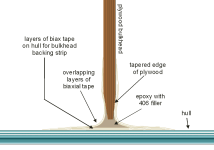Should you run a layer of glass up the side of the hull, contiguous with the bottom? It would stiffen the hull up and not be a bad idea, but you do need to sand that area and be sure that the edge of the glass is smoothed in.
An example is the way we did the deck on my Caracal Cat. We left about 3" of old deck all around the sides of the hull. In this case we removed balsa core (even if good) out to the side of the hull. We put new core (Coosa 20) in with slightly thickened epoxy, but with a 1/4" gap between the horizontal edge of the Coosa 20 and the vertical hull side.
That is not tabbing: The below illustrates tabbing;

.
There are many ways to form the radius where the wood meets the hull, but it boils down to the hard 90* of the bulkhead at the hull, will cause print thru--a hard spot of the bulkhead against the side of the hull. If the laminate is sufficiently thick, I do not put the layor on the hull to begin with. I have used microballons and Cabosil or various foams which do not dissolve in the resin used. I have a tutorial on how to make a fillet in my album however this is hard board to hard board--no space as there should be as illustrated above. I don't taper the wood, and start with widest glass strip first. You do a single layer tab to hold furniture in place. Tabbing can be complex as illustrated, or just a single layer.
Unfortunately C Dory seems to use a single layer of cloth between the aft cabin bulkhead and the hull. That is not adequate and has led to rot in the core of that aft bulkhead, and water intrusion from the bilge (especially in boats with decked over cockpit floor. Why? Again price. Each step, and a bit more cost.
A few builders did it correctly. Way back when I was racing--there are a certain number of racers who represent a brand--hull, sails etc. They get discounts, often "factory" help, and then sell the boat after XX years with a good racing reputation. Those boats were often featured in ads for the various companies. I ordered a 35' boat from a major builder which was one of those project type situations--in that case I had Baxter and Cicero sails, other times I had Watt's or North Sails. I put the 35' boat thru its paces driving it hard for a couple of weeks, then called the engineer at Columbia/Coronado and suggested some "H" section be glassed into the hull to stiffen it up on the run aft, and to beef up the major bulkheads where the chainplate load was distributed.--also some more stiffening the boat for and aft, so that the hydraulic backstay tensioner would not distort the hull, plus put a larger aluminum extrusion in the way of where the mast was stepped on the forward edge of the keel to take that added load...After some discussion, the changes were effected at the local shipyard, rather than sending the boat back to the factory. The results were that I had a "stronger" boat than the average--and it made a difference. I had no hull distortion from wave action, and from higher than "usual" tension on the forestay and backstay. (For the benefit of those who have raced their sailboats.). The sails often went back to the loft a number of times to be slightly reinforced and recut to give a better shape as they stretched from use. Again--a faster boat.

